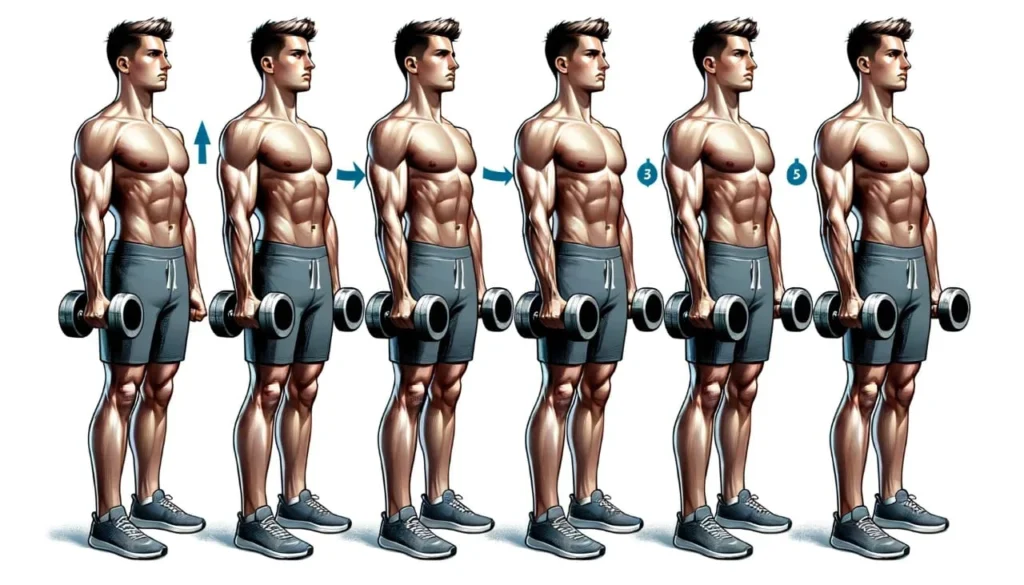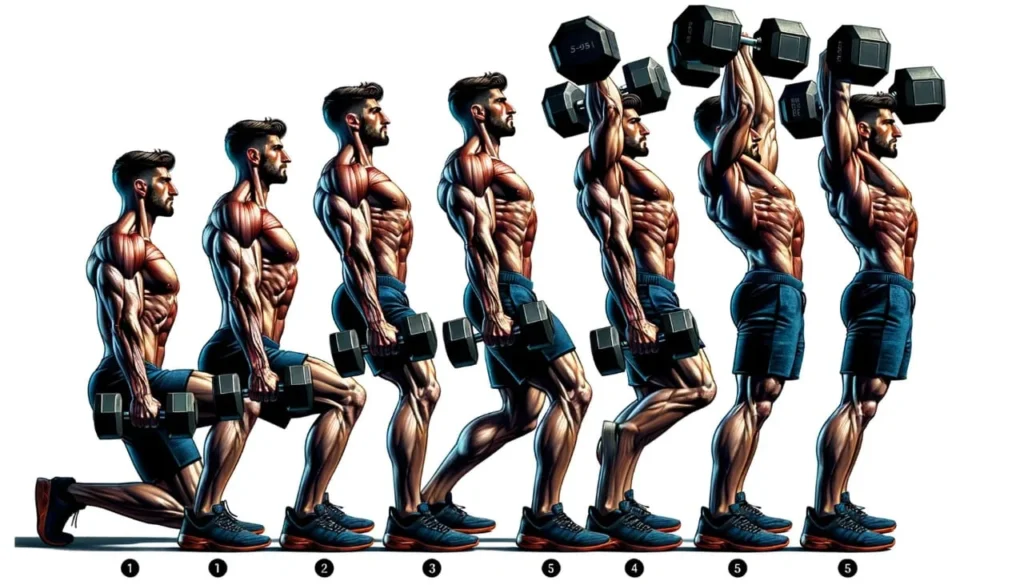Introduction: Elevate Your Strength with Dumbbell Shoulder Workouts
Welcome to the definitive guide to dumbbell shoulder workouts, where we unlock the secrets to building strength, enhancing muscle definition, and achieving the sculpted shoulders you’ve always desired. Dumbbell exercises offer unparalleled versatility and effectiveness for shoulder development, catering to all fitness levels from beginners to advanced athletes. This guide illuminates the path to stronger shoulders through a curated selection of 15 key exercises, each designed to target every aspect of the shoulder muscles.

Discover the benefits of integrating dumbbell workouts into your routine, including improved muscle symmetry, increased range of motion, and the convenience of training anywhere. As we delve into each exercise, we’ll provide visual aids and references to instructional videos where relevant, ensuring you have all the tools necessary to perform each movement with precision and confidence. Embrace the journey to elevating your strength with dumbbell shoulder workouts tailored to transform your physique and boost your overall fitness.
The Top 15 Dumbbell Shoulder Exercises for Maximum Gains
An overview listing all 15 exercises to be discussed, serving as a roadmap for the reader.
- Standing Dumbbell Press
- Dumbbell Lateral Raises
- Seated Arnold Press
- Front Raises
- Bent-Over Reverse Flyes
- Dumbbell Shrugs
- Upright Rows
- One-Arm Dumbbell Snatch
- Dumbbell Scaption
- Standing One-Arm Dumbbell Press
- Dumbbell Cuban Press
- Dumbbell Push Press
- Alternating Deltoid Raise
- Dumbbell Incline Row
- Rotator Cuff External Rotation
- Conclusion
- FAQs
Each of these exercises brings unique benefits to your shoulder development journey, focusing on strength, flexibility, and endurance. Let’s dive deeper into how to perform each one effectively.
1. Standing Dumbbell Press
Benefits: The Standing Dumbbell Press is a comprehensive shoulder exercise targeting primarily the anterior deltoids, with secondary engagement of the medial deltoids, triceps, and upper pecs. It enhances shoulder strength, stability, and overall upper body aesthetics.
How-To Guide:
Sets and Reps: Beginners should start with 3 sets of 8-10 reps, intermediate users can aim for 4 sets of 10-12 reps, and advanced individuals may perform 5 sets of 12-15 reps.
Expert Tips: Maintain a neutral spine and engage your core throughout the exercise. Avoid locking your elbows at the top to keep tension on the shoulder muscles.
2. Dumbbell Lateral Raise
Benefits: The Dumbbell Lateral Raise is instrumental in sculpting the medial part of the deltoid muscles, which is key for achieving broad, well-defined shoulders. This exercise aids in enhancing shoulder width and improving postural support.
How-To Guide:
Sets and Reps: Beginners should aim for 3 sets of 10-12 reps, intermediate lifters can try 3-4 sets of 12-15 reps, and advanced individuals may perform 4-5 sets with 15-20 reps.
Expert Tips: Keep your core engaged and avoid using momentum to lift the weights; the movement should be controlled and focused. Ensure not to lift your arms above shoulder height to maintain tension on the deltoids and minimize the risk of injury.
3. Seated Arnold Press
Benefits: The Seated Arnold Press is an advanced shoulder exercise that targets multiple parts of the deltoids, promoting muscle growth and strength throughout the entire shoulder region. It uniquely combines a press with a rotation, engaging not only the anterior and medial deltoids but also the upper back muscles.

How-To Guide:
Sets and Reps: For beginners, start with 3 sets of 8-10 reps. Intermediate users can aim for 3-4 sets of 10-12 reps, and advanced individuals might do 4-5 sets of 12-15 reps.
Expert Tips: Maintain a strong posture throughout the exercise, and ensure a full range of motion for optimal muscle engagement. Avoid arching your back as you press the dumbbells overhead.
4. Front Raises
Benefits: Front Raises primarily target the anterior deltoids, enhancing shoulder definition and strength. This exercise also engages the upper chest and helps improve shoulder mobility.

How-To Guide:
Sets and Reps: Begin with 3 sets of 8-12 reps for beginners, progressing to 4 sets of 12-15 reps for more experienced individuals.
Expert Tips: Keep your core engaged to stabilize your body and prevent swinging the weights.
5. Bent-Over Reverse Flyes
Benefits: This exercise targets the rear deltoids, critical for a balanced shoulder development and posture improvement, also engaging the upper back.


How-To Guide:
Sets and Reps: Start with 3 sets of 10-12 reps, moving to 4 sets as you build endurance.
Expert Tips: Focus on squeezing your shoulder blades together at the top of the movement for maximum engagement.
6. Dumbbell Shrugs
Benefits: Dumbbell Shrugs strengthen the trapezius muscles, enhancing the upper back and neck area, and contribute to shoulder stability.


How-To Guide:
Sets and Reps: 3 sets of 12-15 reps are ideal for beginners, with increased weight for advanced practitioners.
Expert Tips: Avoid rolling your shoulders, focusing on a vertical lift to effectively target the traps.
7. Upright Rows
Benefits: Targets the deltoids and trapezius muscles, enhancing shoulder and upper back strength. Improves posture and shoulder stability.

How-To Guide:
Expert Tips: Keep the lift close to your body for maximum efficiency. Avoid pulling too high to keep the shoulders safe.
8. One-Arm Dumbbell Snatch
Benefits: A powerful compound movement that builds shoulder strength, explosiveness, and improves overall athleticism. Engages core and lower body for a full-body workout.

How-To Guide:
Expert Tips: Focus on form and fluidity of movement. Practice with lighter weights to master technique before increasing weight.
9. Dumbbell Shrugs
Benefits: Specifically strengthens the trapezius muscles, contributing to better posture and shoulder stability.

How-To Guide:
Sets and Reps: Start with 3 sets of 12-15 reps, focusing on controlled movement.
Expert Tips: Avoid rolling your shoulders or using momentum; the motion should be vertical.
10. One-Arm Standing Dumbbell Press
Benefits: Focuses on unilateral strength, improving muscle balance and core stability by engaging one side of the shoulder and torso at a time.


How-To Guide:
Sets and Reps: 3 sets of 8-12 reps per arm, suitable for all levels.
Expert Tips: Keep your core tight throughout the exercise to support your spine and enhance balance.
11. Dumbbell Cuban Press
Benefits: Enhances shoulder mobility and strength, targeting the rotator cuff muscles in addition to the overall deltoid development.

How-To Guide:
Sets and Reps: 3 sets of 8-10 reps, focusing on controlled movement.
Expert Tips: Move through each phase of the exercise slowly to maximize engagement and minimize injury risk.
12. Dumbbell Push Press
Benefits: Combines strength and explosive power, engaging the shoulders, core, and lower body, making it a comprehensive upper body exercise.

How-To Guide:
Sets and Reps: 3-4 sets of 6-8 reps, incorporating explosive movement.
Expert Tips: Use the power from your legs to help drive the dumbbells overhead, enhancing the exercise’s effectiveness.
13. Alternating Deltoid Raise
Benefits: The Alternating Deltoid Raise targets the lateral deltoids, enhancing shoulder width and definition. This unilateral exercise also helps correct muscle imbalances between the left and right sides.

How-To Guide:
Sets and Reps: Perform 3 sets of 10-12 reps per arm, focusing on maintaining proper form throughout.
Expert Tips: Keep your core engaged and avoid excessive swinging or momentum to ensure targeted muscle engagement.
14. Dumbbell Incline Row
Benefits: The Dumbbell Incline Row primarily targets the upper back muscles, including the rhomboids and trapezius, while also engaging the biceps. This exercise improves posture and upper body strength.

How-To Guide:
Sets and Reps: Aim for 3 sets of 10-12 reps, gradually increasing weight as you become stronger.
Expert Tips: Focus on initiating the movement from the back muscles rather than the arms to maximize muscle activation.
15. Rotator Cuff External Rotation
Benefits: The Rotator Cuff External Rotation targets the muscles of the rotator cuff, promoting shoulder stability and reducing the risk of injury. This exercise is particularly beneficial for individuals involved in overhead activities or sports.

How-To Guide:
Sets and Reps: Perform 2-3 sets of 12-15 reps per arm, focusing on proper form and controlled movement.
Expert Tips: Keep your shoulder blade stable throughout the exercise to isolate the rotator cuff muscles effectively.
Maximizing Shoulder Strength: A Comprehensive Guide to Dumbbell Exercises
After delving into fifteen dynamic dumbbell exercises for sculpting and strengthening the shoulders, let’s consolidate our insights and explore additional avenues for optimizing your shoulder workout routine.
1. Recap and Key Insights
Throughout this guide, we’ve explored a diverse array of dumbbell exercises tailored to enhance shoulder strength, stability, and aesthetics. From the foundational Standing Dumbbell Press to the targeted Rotator Cuff External Rotation, each exercise offers unique benefits and contributes to a well-rounded shoulder training regimen.
2. Fine-Tuning Your Shoulder Workouts
As you continue your journey towards peak shoulder performance, consider integrating these exercises into structured routines and exploring variations to challenge your muscles in new ways. Whether you’re aiming for muscle hypertrophy, improved functional strength, or injury prevention, a strategic approach to exercise selection and progression is key.
3. Exploring Further Resources
For an expanded repertoire of shoulder exercises and in-depth guidance on optimizing your shoulder workouts, I recommend exploring our comprehensive resource on 17 Essential Shoulder Exercises. This detailed guide offers additional insights and variations to support your shoulder training journey.
4. Crafting Your Perfect Shoulder Workout
Crafting an effective shoulder workout involves careful consideration of your fitness goals, level of experience, and overall training routine. To tailor your workout for optimal results, follow these steps:
For more detailed guidance on crafting a tailored workout plan, check out this article on Muscle & Fitness for insights from fitness experts and customizable workout templates.
5. Enhancing Your Routine: Expert Contributions and Advanced Techniques
Elevate your shoulder training by incorporating insights from fitness experts and advanced techniques:
For additional expert advice and advanced training techniques, refer to this resource from Bodybuilding.com for detailed workout plans and instructional videos.
6. Common Shoulder Training Mistakes and How to Avoid Them
Avoid common pitfalls in shoulder training to prevent injuries and maximize results:
Refer to this article from Healthline for more information on common shoulder training mistakes and how to avoid them, based on expert advice and scientific research.
Conclusion: Your Path to Stronger, Sculpted Shoulders
In conclusion, achieving stronger, sculpted shoulders is within your reach with the right knowledge and dedication. By incorporating the insights and techniques shared in this guide, you’re on your way to maximizing your shoulder training and reaching your fitness goals. Here is a crucial detail to keep in mind:
Now, armed with knowledge and determination, it’s time to embark on your journey to stronger, sculpted shoulders!
FAQs: Addressing Your Shoulder Workout Queries
Here are answers to some common questions to further enhance your understanding of shoulder workouts:
